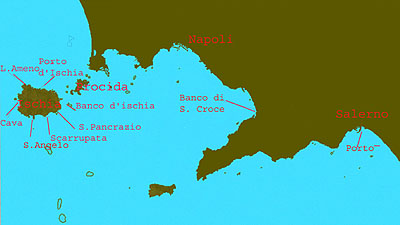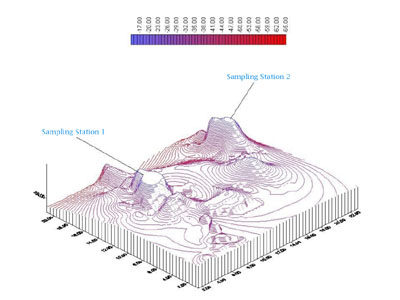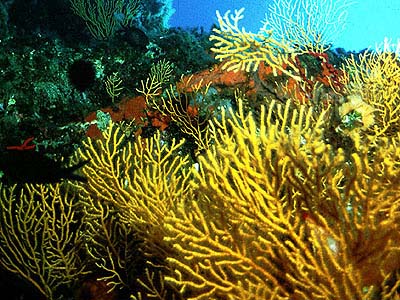Biodiversity of the Banco di Santa Croce, a marine protected area in
the Gulf of Naples
Valerio Zupo
Stazione Zoologica A. Dohrn,
Benthic Ecology Laboratory,
Punta San Pietro,
80077 Ischia (NA), Italy
 |
Figure 1. Bank of Santa Croce, Gulf of
Napoles.
The Bank of Santa Croce is a protected area located in the Bay of
Naples (Fig. 1) characterized by a series of carbonate rock hills (Fig.
2) hosting highly differentiated benthic communities. Photophilic
associations with dominance of brown algae (Padina pavonica and
Sargassum sp.) dominate the top of hills, while macroalgal assemblages
typical of sciaphilic environments (Peyssonellia borneti and Flabellina
petiolata) characterize the vertical walls. Zoocenoses are dominated by
Eunicella cavolinii, Parazoanthus axinellae, Paramuricea clavata and
Gerardia savaglia. Species characteristic of "very stable"
environments (e.g., red coral) are present mainly at the deeper stations
(>20 m), but also the shallowest sites (11 m) contain, almost
exclusively, "climax" benthic communities. Benthic fauna is
highly diverse (Fig. 3) and the presence of decapods previously known
only for the Adriatic Sea (e.g., Palicus caronii Roux, 1830) was
recorded. Abundant fish stocks, mainly represented by members of the
families Labridae, serranidae and sparidae, characterise the area.
However, two young specimens of Zu cristatus Bonelli 1819 were recently
observed in shallow waters: this species was considered oceanic and
mesopelagic.
 |
Figure 2. Model of the bank, reconstructed
using a 'kriging' interpolator.
Our Research Programme (P.I. V. Zupo and M.C. Buia) was aimed at the
characterization of ecological descriptors and at the investigation of
structural and functional relationships benthos-nekton-plankton within
this protected area, to allow the formulation of an effective management
and protection plan.
Several data-sets were collected and analysed
(Nutrient concentration in the water column, chemical and physical
descriptors, water currentometry, fractioned chlorophyll, micro- and
macro-zooplankton, fish stocks evaluated by visual census and
collections by nets, gut contents of fish and benthic invertebrates,
faunistic and floristic composition of benthic assemblages, heavy metal
contents of the tissues of fish) to obtain a dynamic model of simulation
of the food web within the area. The model, based on budget equations
for each of the 552 species identified, was calibrated and validated
based on the data collected during a 3-year investigation. The model
demonstrated that, despite the fishing prohibition regime, the area is
impacted by the collections of benthic and nektonic organisms.
 |
Figure 3. View of shallow communities,
illustrating the great biodiversity of the Bank area.
It was also recorded the great biodiversity of the area and the
function of the bank as an energy transducer, based on the continuous
transformation of organic matter deriving from the Sarno River in
production of biomasses of high economic value. The productivity peaks
in spring and summer and the total export of animal biomass to
surrounding systems is about 23 kg yr-1 m-3 . These biomasses are not affected by inorganic pollution, as demonstrated by the analyses of
heavy metals. The sensitivity analysis demonstrated that high
productivities of the bank are sustained by both the input of organic
matter (transported by strong currents), and the local primary
production. The analysis indicated that a higher level of protection of
benthic communities and the preservation of the present hydrodynamic
patterns will allow an optimal management and an increase of the export
of fish biomass.
The coastal areas around the Sarno River are considered among the
most impacted by organic and inorganic pollution, in the whole
Mediterranean basin. It was very interesting to detect highest levels of
biodiversity into the bank (which is located within this area). The
results of the Research Programme opened new perspectives in the study
of the relationships between human impacts and diversity and highlighted
the existence of unresolved ecological paradigms, worth to be
investigated.
|
